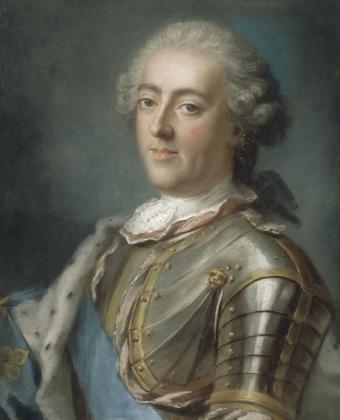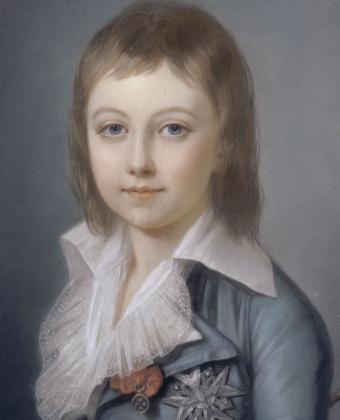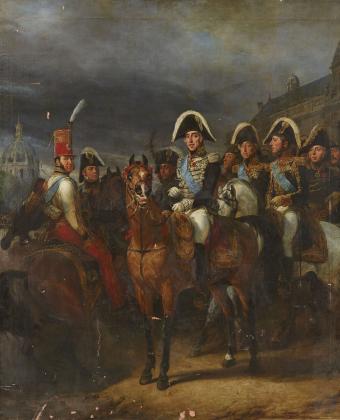Louis XVI was the grandson of Louis XV. He became Dauphin in 1765 and inherited the throne in 1774 at the age of 20. His governor, the Duke of La Vauguyon, provided him with a well-rounded education but singularly failed to prepare the young prince for the concrete challenges of government. This lack of preparation was compounded by the fact that he was only the third royal son and did not become heir apparent until after the death of his two elder brothers. The future Louis XVI studied history, geography, science, law, Latin and Greek as well as various modern languages. His political philosophy was influenced by Fénelon and the thinkers of the Enlightenment, who held that the nation existed independently of the king – an idea which challenged the traditional conception of the French monarchy. Upon taking the throne Louis XVI decided to dispense with the political team assembled by his grandfather, Louis XV, and replaced them with ministers such as Turgot, Necker and Calonne. Although serious financial troubles beset the country, the king lent only ambivalent support to their efforts to suppress some of the nation’s many fiscal exemptions. These reforms were doomed to failure, and Louis XVI was eventually obliged to summon a meeting of the Estates General at Versailles, in May 1789. This extraordinary assembly brought together 1200 representatives of the three “orders” which made up the nation: the clergy, the nobility and the third estate. The French Revolution was underway.
The Royal Family
In 1770 the Dauphin Louis, future Louis XVI, married Marie Antoinette de Habsbourg-Lorraine, Archduchess of Austria. Together they had four children. Only the eldest, Madame Royale, born in 1778, and the Second Dauphin, born in 1785, survived to see the outbreak of the French Revolution. In the court the King was surrounded by his brothers, the Count of Provence and the Count of Artois and their wives, as well as his sister Madame Élisabeth.
A learned king
Louis XVI indulged his interest in the applied sciences and the latest technical and mechanical curiosities in the special cabinets and laboratories he had installed near his private chambers. They included workshops devoted to physics, mechanics, chemistry, woodworking, watchmaking and lock-making, along with a working forge and a room for experiments involving electricity. The king also took a keen interest in maritime exploration and the discovery of new lands. In the 1780s he sponsored the explorer Jean-François de La Pérouse for his circumnavigation of the globe. In 1783 the king hosted the first aeronautical experiments at Versailles: on 14th September, Étienne de Montgolfier floated a balloon filled with hot smoky air and carrying a basket holding a sheep, a rooster and a duck over the palace. On 21 November, Pilâtre de Rozier took off from Versailles and succeeded in remaining airborne for 25 minutes.
Life at the Court
Throughout the eighteenth century, the kings of France devoted more and more time to their personal lives at the expense of their ceremonial lives, i.e. the rituals through which they embodied power. Louis XVI’s approach to the exercise of power left little room for contact with his subjects. On certain evenings the King did hold semi-official suppers in his private apartment, with around 60 guests including the Queen, other members of the royal family, ministers and courtiers. But the royal entourage was not as numerous or as brilliant as it had been in Louis XIV’s days, and Paris overtook Versailles as the centre of cultural life.
The French Revolution, the final years of Louis XVI
At the outset of the Revolution, Louis XVI adopted a pro-reform stance. But the King was indecisive and reluctant to ratify the texts proclaiming the abolition of privileges and the Declaration of the Rights of Man, promulgated shortly after the storming of the Bastille on 14 July 1789. On 5 October 1789 a mob descended on Versailles and demanded that the royal family decamp to Paris. The King was transferred to the Tuileries Palace, before attempting to flee in June 1791. Arrested in Varennes, he was brought back to Paris. In 1792 he was tried by the revolutionaries. The monarchy was formally abolished, and “Year I” of the French Republic was declared. Louis XVI died at the guillotine on 21 January 1793. He was the last king to live at the Palace of Versailles, and the revolutionaries duly gave him the nickname “Louis the Last”.
A philosophical king
His political philosophy was influenced by Fénelon and the thinkers of the Enlightenment, who held that the nation existed independently of the king – an idea which challenged the traditional conception of the French monarchy.











